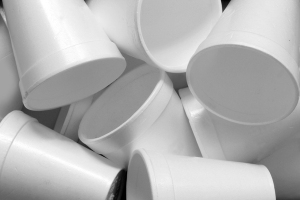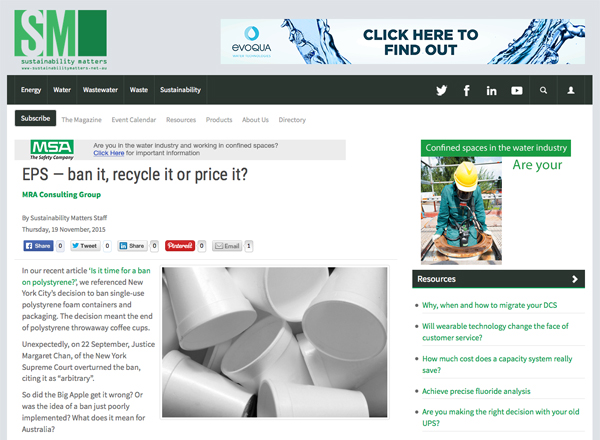EPS – Ban it, recycle it or price it?
 In our recent article ‘Is it time for a landfill ban on polystyrene?’, we referenced New York City’s decision to ban single-use polystyrene foam containers and packaging. The decision meant the end of polystyrene throw away coffee cups.
In our recent article ‘Is it time for a landfill ban on polystyrene?’, we referenced New York City’s decision to ban single-use polystyrene foam containers and packaging. The decision meant the end of polystyrene throw away coffee cups.
Unexpectedly, on 22 September, Justice Margaret Chan, of the New York Supreme Court overturned the ban citing it as ‘arbitrary’.
So did the Big Apple get it wrong? Or was the idea of a ban just poorly implemented? What does it mean for Australia?
Consumer Products
Expanded polystyrene (EPS) packaging accounts for only 0.2% by weight of the Australian waste stream, but is a significant component of both litter and the volume of waste disposed at landfill.
As a product, single-use EPS (e.g. coffee cups, ‘clamshell’ containers, and packaging support around electronics) is technically 100% recyclable. But it is dispersed throughout the economy and is generally uneconomic to recover.
From a householder point of view, if you have a couple of coffee cups or polystyrene packaging around a single TV, you are hardly likely to drive to a drop off facility to see it recycled. It is also not viable for a commercial collector to make a trip to collect it. As a result the vast majority of post-consumer EPS ends up in the general waste bin.
The Alternatives
You may have noticed that the inside packaging of white goods, electronics and the like, is increasingly being made of cardboard, moulded pulp or deflatable plastic pillows. Most of these products are easily recycled.
There are also companies experimenting with packaging products that have similar properties to EPS but are made from renewables like sugarcane and corn by products[i]. But right now EPS is cheaper and entrenched.
So why do we persist with EPS packaging, when alternatives are readily available and easily recycled?
Building Products
EPS is lightweight, inert and (according to some building product suppliers) does not seep chemicals or gases. It has high load bearing capacity making it perfect as a construction material. It has strong thermal resistance, making it perfect as an insulation product[ii].
The feedback we received from our first article on EPS was virtually unanimous that EPS had few redeeming features as a packaging product and was easily substituted, but that as a building product it was unique and largely irreplaceable.
So the question then is “Do we need EPS consumer packaging in order to supply recycled EPS to the building sector?” What effect would an EPS packaging ban have on building product supply?
The answer is virtually none.
The majority of EPS used in building material comes from virgin product. There are a couple of companies in Australia that supply recycled EPS[iii] to the construction industry, but the tonnages of recycled EPS are tiny. The products include low-grade insulation board and block moulded products (such as Waffle Pods[iv]; that use granulated EPS mixed with plaster or concrete).
Can it be done?
There is little dispute that there are many ways to substitute consumer packaging EPS (e.g. cups, trays and moulded supports of TV’s) with more environmentally friendly products, such as cardboard and paper pulp.
This type of post-consumer EPS packaging is light, bulky and is widely distributed throughout the economy making its collection and reprocessing virtually uneconomic. Therefore most ends up in landfill.
In the building sector, substitution is neither easy nor commercially viable. Having said that, the building industry currently sources most of its EPS from virgin material and is not dependent on domestic EPS recyclers for supply. So a ban on consumer packaging EPS would have little effect on the building sector.
Given that an EPS packaging ban (such as New York’s recent attempt) would need to be national (since it would need to capture imported products such as TV’s), it would need the cooperation of all levels of government. That I believe makes a ban highly unlikely.
More likely and more effective, in my view, would be to extend the existing TV/Computer EPR schemes to include their polystyrene packaging combined with State based discretionary landfill levies on EPS packaging. These two mechanisms standing together or separately, would send a clear price signal to the market. Of course it will take time for this to work and is a less direct signal than a ban.
The consumer also has some limited power by purchasing products that use substitutes of EPS. But it is unlikely to have long-term impacts on the quantity and presence of EPS in the market.
As always, I welcome your feedback on this, or any other topic on ‘The Tipping Point’.
By Mike Ritchie
[i] BioPack – http://www.biopak.com.au/
[ii] Build – http://www.build.com.au/polystyrene-insulation
[iii] Polystyrene Recycling Queensland – http://www.polyrecycleqld.com.au/about-polystyrene.html
[iv] Department of Sustainability, Environment, Water and Communities… Construction and Demolition Waste Guide – Recycling and Re-use Across the Supply Chain (2011) – //www.environment.gov.au/system/files/resources/b0ac5ce4-4253-4d2b-b001-0becf84b52b8/files/case-studies.pdf




